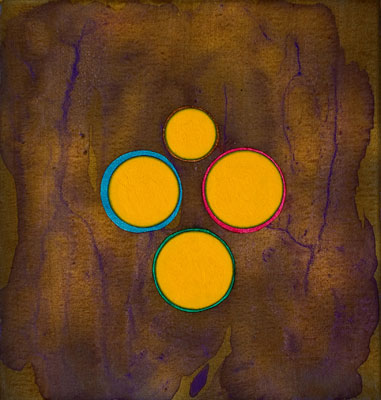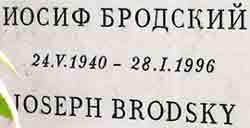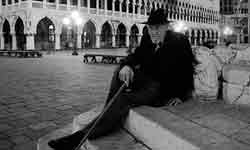Grotesque Image: Gods and Monsters
sitemap
drawings
paintings 1 2 3 3 4 5 a b c -
- A B . . . . . . . new
installations
projects
reviews
Joseph Brodsky (1940-1996) |
Joseph Brodsky (1940-1996) |
Grotesque Image: Gods and Monsters
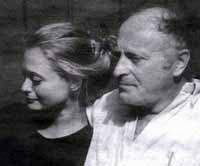
Maria Sozzani Brodsky and Joseph Brodsky, 1990.
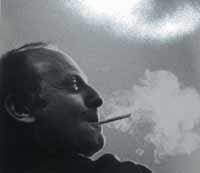
Joseph Brodsky
Thomas Henry Martin
Gods and Monsters (Part 1)*
This is a love story. With all of its complexities and academic rhetoric and dusty quotes, this is nothing more than a tragic little love story. The lovers never managed to embrace in the end. They were torn apart by the world they inhabited. In the end they remained apart, drifting to their own little corners of the world that battered them about. Oh, I believe they tried to come together. They desperately tried to remake their angry world. They searched and tore apart and rebuilt everything they thought would help to remake this world, or at least to connect back to it, to be a part of it. They wanted to rid themselves of that feeling of alienation: that feeling of drifting outside of the world they inhabited. That was their passion: to connect, to transform and to connect. They were grasping at completeness, because, alone, they knew they were withering away.
These lovers were poets. At one time they were engaged. But the environment in which they lived became too corrosive for their own personalities as well as for their relationship. One lover followed the other half way around the world in order to maintain the relationship. Unfortunately, the urban environment half way around the world was much the same. Too many obstacles appeared: obstacles that were a part of their own characters. After all, they were affected by their own environment. The two poets were H.D. and Ezra Pound.
As in every love story there were other characters involved as well. And in this one, the main supporting players were William Carlos Williams and Sigmund Freud.
Neither character participated directly in the relationship between H.D. and Ezra Pound.
However, they did manage to illuminate the common bond between the two poets. The third poet, William Carlos Williams, also shared a similar desire. These three poets were concerned with the idea of unifying the inhabitants of the cities, particularly American cities, with their constantly changing environment. All three felt that poetry was a useful tool in orienting their reader to the changing environment of the cityscape. Other poets, such as Marianne Moore, Mina Loy and T. S. Eliot, also felt poetry could be used for such a task.
Ezra Pound
However, the poet works out a poetics to deliver the audience from being alienated from their environment to feeling attune with it. This power involves mastering the nature of the grotesque, because the grotesque, properly invoked, brings forth complete metamorphosis. The reason American poets of the high modernist period wished to access the grotesque as a tool for metamorphosis concerns the rise of the city as a locus for determining contemporary character. The city is grotesque in its power to transform nature into manmade objects. However, the built environment is constantly in metamorphosis, according to Henri Lefebvre and Michel de Certeau. This constant state of flux creates problems for the inhabitants of the city. For an inhabitant to survive, he must constantly be adept at navigating and, in some cases, manipulating his environment.
In order to be adept in the city as an environment, the inhabitant must endure the constant changes of an industrialized landscape, as well as recognize its basis in the artificial. By the end of the nineteenth century, most of the inhabitants of western, particularly American, cities did not see the city in its artificial, mercurial state. In The Revolt of the Masses, Jose Ortega y Gasset describes how the environment of the modern city is inhabited by a type of human being he labels a Naturmensch: a human being who can only read his surroundings in a pastoral sense.
The world is civilized, but the inhabitant is not: he does not even see its
civilization, but uses it as if it were a part of nature. The new man wants his automobile, and enjoys using it, but he thinks it is the spontaneous fruit of some Eden-like tree. His mind does not encompass the artificial, almost unreal nature of civilization, and the enthusiasm he feels for its instruments does not include the principles which make them possible. (Ortega y Gasset 70)
The urban environment twisted the natural forms of nature into mechanical shapes, such as the ivy patterns on buildings or the embossed figures of flowers decorating locomotives and dynamos of power plants. When Prince Albert opened the Crystal Palace exhibition in 1851, he designed a series of hothouses in which nature and the machine are merged into a new hybrid figure. This hybrid figure was part nature, part a highly figurative projection of human Romanticism that shows the natural world as a kind of scrim on which to elaborate human subjectivity and dreams, fantasies and desires having nothing to do with the organic process.
What Pound discovered is that the free use of nature to fabricate human meaning could be found in Greek myth, as in the story of Daphne and her transformation into a laurel tree. The boundary between nature and the human world of ideas and desires becomes more porous down through the nineteenth century with the built environment absorbing the nature it displaced with its sprawl and complexity. In a way, the grotesque image is a vision of how the inanimate things of human manufacture are animated by their absorption of nature into their design. The analogic thinking that lies behind the grotesque image, a perception of similarity connecting organic life with the fruits of mechanistic engineering, transcends the boundary earlier centuries had raised between what man makes and what God created. Suddenly, the one world is free to inhabit the other in a visionary truce of sorts, in which a woman is once again able to become a tree, or the tree to become the Eiffel Tower, or the skyscraper to reflect the forest long since removed from Manhattan. This “shape shifting” of modernist architecture may well have reached its climax with Frank Lloyd Wright’s “Johnson’s Wax Building,” with its enormous lily pads holding up a roof over the main office space. Nature and man were forged into a new alliance in which both terms lost their status as polarities in a war of the spirit. Neither nature nor the built environment was purely alien or apart so long as the grotesque image bonded them.
Modernist poets actually found the grotesque image a source of vitality in the early part of the twentieth century. The grotesque image in such paintings as Pablo Picasso’s Les Demoiselles d’Avignon had its equal in the images created in modernist poetry. The use of the grotesque image, in poetry, broke down boundaries between author and audience by foregrounding the city. The particular environment that represents modernist experience most clearly is the cityscape. The cityscape is where industrialization places its impetus for change. The urban landscape is the womb of industrialization, in as much as urban areas with their concentration of labor pools are the location of factories. In return, the products from these factories hasten the transformation of the urban and rural environments. As witnesses to industrial culture, William Carlos Williams, H.D., T. S. Eliot, Marianne Moore, Mina Loy and Ezra Pound use the grotesque image to bond the body with the mind or soul and provide an interactive language that connects the individual to the environment of the city. The grotesque image is often placed in a city and it is this context that the modernist poets wish to make their transformation.
Most scholarship has ignored the modernists’ use of the grotesque. Critics like Marjorie Perloff consider Hugh Kenner’s The Pound Era to be the quintessential text in the analysis of Ezra Pound, T. S. Eliot, Henri Gaudier-Bzreska and Wyndham Lewis. However, in his chapter on Wyndham Lewis, Kenner underestimates the role of the grotesque in modernist poetry. His prejudice against the grotesque image closed discussion on how aberrant vision functions in modernist poetry. In his analysis of Wyndham Lewis’s transformation as an artist, Kenner states:
[a] grotesque is an energy which aborts, as if to express its dissatisfaction with available boundaries, as a dwarf may be nature’s critique of the tailor’s dummy. Lewis’s earlier pictures announce an energy art cannot accommodate. That summer Art and Energy moved into sudden conjunction; forms filled his spaces, not forms arrested in grotesquerie but forms locked in passionate stases. (Kenner 232)
Kenner’s analysis implies that Lewis’s transition into modernism occurs through his renunciation of the grotesque image in his art. Of course, this analysis also implies that the grotesque image lies outside the frame of modernism, which includes imagism and vorticism. In Kenner’s view, modernist work influenced by imagism and vorticism must reject the grotesque image altogether.
Kenner’s definition of grotesque does not take into account a more contemporary definition of the term influenced by Mikhail Bakhtin. Kenner ignores the fact that the grotesque encompasses a complete transformation of one state into another, such as the grotesqueries found in Ovid’s Metamorphoses. However, the grotesque can also remain static: an entity unable to make a complete transformation and is locked in the moment of transition, unable to change. This second understanding of the grotesque reached its height of popularity in sideshow carnivals during the nineteenth century. Kenner only takes the second understanding of the grotesque into account and never considers the importance of how the dynamic side of the grotesque may have played a role in the writing of poetry during the high modernist period, particularly by Ezra Pound, H. D., and William Carlos Williams.
High modernist writers explored the former, more classical understanding of the grotesque. They wished to retrieve the grotesque in its classical form as complete transformations into other states because that definition could be used as a tool for showing metamorphosis. The grotesque found in Ovid’s Metamorphoses, with its multiple characters becoming new entities in order to survive, provided the type of grotesque modern poets wished to recapture.
Texts that enact such transformations, such as Ovid’s, had been maligned after the Enlightenment. For example, Immanuel Kant attacks the grotesque for lack of examples of complete transformations found in nature. In Observations on the Feeling of the Beautiful and Sublime, Kant dismisses the grotesque as antagonistic to rational thinking. Kant’s definition claims “Unnatural things, so far as the sublime is supposed in them, although little or none at all may actually be found, are grotesque” (Kant 55). Kant designates the quality of classical literature on a scale that goes from the sublime or noble, which he ranks as superior, to the adventurous, in which a character controls natural urges through reason, and finally to the grotesque, which he ranks at the bottom. “Of the works of wit and fine feeling, the epic poems of Virgil and Klopstock fall into the noble, of Homer and Milton into the adventurous. The Metamorphoses of Ovid are Grotesque” (Kant 57).
Subsequent generations influenced by Kant received this interpretation of the grotesque. Kant’s interpretation combines the grotesque into one negative unnatural terrifying image that only repels its audience through its inability to adhere to the accepted natural image.
Even later nineteenth century philosophers and writers, such as John Ruskin, saw the grotesque as a degenerative, unnatural image, despite their attempts to see the grotesque as productive. For example, John Ruskin saw the grotesque as essential in all art because the grotesque arose from the artist at play with ideas or situations. Ruskin divided the grotesque into two types: the noble and the ignoble or false grotesque. Ruskin saw the works of Plato and Dante as examples of the noble grotesque because these writers framed their creativity, the context of their writing, within a highly sublime or rational structure. The ignoble grotesque, on the other hand, is formed by artists who do not place their creativity into a sublime or rational structure (Clayborough 36-7).
Ruskin’s definition of the grotesque follows Kant’s in how he identifies the extreme noble grotesque, which he calls the terrible grotesque. The terrible grotesque is the most noble image because it comes from the artist’s unconscious; as such, it is the artist’s image most closely related to the divine. These grotesque images are fears that the artist must express to rid himself of their terror.
The grotesque which we are examining arises out of that condition of mind which appears to follow naturally upon the contemplation of death, and in which the fancy is brought into morbid action by terror, accompanied by the belief in spiritual presence, and in the possibility of spiritual apparition. Hence are developed its most sublime, because its least voluntary, creations, aided by the fearfulness of the phenomena of nature which are in any wise the ministers of death, and primarily directed by the peculiar ghastliness of expression in the skeleton, itself a species of terrible grotesque in its relation to the perfect human frame. (Ruskin 170)
The images of the terrible grotesque are, therefore, repulsive to the audience as well as to the artist. Although ranked as the highest quality of the grotesque, the terrible grotesque still holds the quality of repulsion. Repulsion is the dominant feature of the grotesque for a majority of critics prior to Mikhail Bakhtin’s definition in Rabelais and His World. Kenner’s consideration of the grotesque as a limiting force in art has considerable support from previous writers.
Despite Kenner’s marginalizing of the grotesque image in the works of the modernist poets, even he discusses various uses of the grotesque in modernist literature. In The Mechanic Muse, Kenner alludes to what would be considered a grotesque image under the definition set up by Mikhail Bakhtin in Rabelais and His World, when he quotes Pound describing his fondness for machinery. When considering a photograph of machinery in nineteenth century England, Pound writes “[t]he NOSE of the big dies, for example, excellent shape. Photos of the detail of the coin press, especially at the point where the force is concentrated” (Kenner 40). Through anthropomorphism, Pound focuses on an essential part of the human face that artists and writers use to create a grotesque image. In Rabelais and His World, Bakhtin notes “[o]f all the features on the human face, the nose and mouth play the most important part in the grotesque image of the body” (316).
Five years before the translation of Bakhtin’s text into English, Indiana University Press (the same press that published Helene Iswolsky’s translation) published Wolfgang Kayser’s The Grotesque in Art and Literature, which explores the grotesque image as an alienating figure. Kayser treats the grotesque as having a repulsive or an alienating effect on its audience. Like his predecessors, Kayser tries to establish a solid definition for the grotesque. Kayser states:
For no matter how often we hear and use the word “grotesque”- and we hear it ever more frequently, since it seems to be one of those quickly cheapened terms which are used to express a considerable degree of emotional involvement without providing a qualitative distinction beyond the rather vague terms “strange,” “incredible,” “unbelievable”- it is certainly not a well-defined category of scientific thinking. In the commonly used auxiliary tools, the literary dictionaries, no entry is usually given under grotesque; and where such an entry exists it might well have been omitted. (Kayser 16-7)
Kayser not only identifies the problem of providing the grotesque with a definition, he also indirectly identifies the grotesque’s conflict with science. The grotesque, once again, opposes the rational analysis on which science is based.
Nevertheless, Kayser pursues his intention to provide the grotesque with a solid definition. Like many scholars intending to define the grotesque, Kayser begins by looking at the semantic origins of the term. He refers to the images on the ceilings and walls of the grotta excavations in Rome during the fifteenth century. These images were first used as decorations in Rome and throughout the Italian peninsula during the early Christian period of the Roman Empire (Kayser 19-20). He then follows the history of the use of the grotesque through the Renaissance up until the early twentieth century. Kayser defines the grotesque as having three facets, the state of the artist while creating the piece of work, the actual work as an object, and the affects of the work on the audience (Clayborough 63). From these three facets, Kayser develops an analysis of the grotesque that provides his new definition. For Kayser, “The grotesque is a structure. Its nature could be summed up in a phrase that has repeatedly suggested itself to us: THE GROTESQUE IS THE ESTRANGED WORLD. […] It is our world which has to be transformed. Suddenness and surprise are essential elements of the grotesque” (Kayser 184). Kayser’s definition requires the grotesque to transform its audience from the familiar, established, static environment that the audience inhabits into a strange, alien environment with no clear orientation or understanding about it. In The Grotesque in English Literature, Arthur Clayborough explains Kayser’s definition of the grotesque:
The difference between the merely unfamiliar and the incongruously strange, that is, between the ephemeral strangeness which is simply due to novelty and the positive, discordant strangeness which is directly opposed to “the natural conditions of organization,” is emphasized by Wolfgang Kayser. The grotesque in art, he maintains, is ‘the alienated world’; not, that is to say, a world which is merely alien, but as he puts it, our own world, so distorted that we no longer wish to live in it […]. (Clayborough 71)
Clayborough identifies Kayser’s use of the repulsive or alienating quality of the grotesque as the focus of the grotesque’s definition.
Two years after Ulrich Weisstein’s translation of Kayser’s text was published, Clayborough published his text on the use of the grotesque in the English language. Like Kayser, Clayborough also goes through the semantic origins of the word ‘grotesque’ at the beginning of his analysis. Clayborough provides a detailed analysis of the grotesque in English literature through different eras in the same way that Kayser analyzes the grotesque in German literature.
However, Clayborough opposes Kayser’s notion that the grotesque excites repulsion in its audience. Clayborough defines the grotesque by its incongruous qualities, and places alienation as a secondary quality that does not always appear in the grotesque:
Grotesqueness is not, of course, synonymous with ugliness; there may be grotesqueness of a kind without the introduction of deformity – possible or impossible – and without the introduction of ‘monstrous’ phenomena (the dinosaur, the rhinoceros, the dragon) or any of the ‘uncanny’ phenomena to which Kayser draws our attention – the bat, the puppet, the skeleton, &c. [sic.] It may lie in the juxtaposition of objects. […] The psychological tendency to seek a relationship between contiguous objects is exploited in grotesque art[.] (Clayborough 72-3)
Clayborough places incongruity as the primary facet in defining the grotesque through the use of psychology.
He begins his psychological analysis of the grotesque with an investigation of language. He looks at the non sequitur and determines whether it is an example of the grotesque by its effect on the audience.
It is […] worth noticing how readily the non sequitur creates an effect of oddness when words, with their greater emotive content, are substituted for mathematical symbols: ‘Well is this place called Stony Stratford, for never was I bitten by so many fleas in my life before.’ An examination of the emotional effect of the non sequitur – usually a humorous effect – sheds light on the nature of our reaction to grotesque art.
Not every non sequitur, even where the form is a verbal one, produces a pronounced emotional effect. Where, however, such an effect is produced by the breach of logical propriety, we may react in either or both of two opposed ways. We may feel a sense of superiority, the amusement of the logician; we may also feel a sense of release, an anti-rational reaction[.] (Clayborough 70)
As will be demonstrated in chapter II, Charles Baudelaire identifies the location of the grotesque in language, and therefore, provides a precursor to Clayborough’s concept of the grotesque being identified in language. However, Clayborough also finds emotion in the audience an essential element in identifying the grotesque.
Clayborough uses the archetypal psychology of Carl Jung in particular when he sets out to define different varieties of the grotesque. He uses the Jungian terms of progression, concerning the conscious, and regression, concerning the unconscious. “It is characteristic of the practical, ‘progressive’ aspect of mind that it should either reject such deliberate juxtapositions as pointless or seek to establish a logical connexion between them. The ‘regressive’ aspect of mind, on the other hand, luxuriates in their inexplicable ‘significance’” (Clayborough 73).
From these two Jungian terms, Clayborough comes up with four types of grotesque. The progressive-positive grotesque provides the audience with actual facts or representations of actual objects that entices the audience to think about the given situation (Clayborough 107). The progressive-negative grotesque creates a seemingly nonsensical situation but demands the audience to associate it with something in their world. Satires are the best examples of this category. Clayborough has a little more trouble explaining the difference between the regressive-positive grotesque and regressive-negative grotesque, both of which deliver an unconscious response from the audience. He evokes Friedrich Schiller to best explain the difference between the two categories. “The difference between these two types of regressive art – which, admittedly, shade off into one another – may perhaps be related to Schiller’s distinction between the naïve and the sentimental types of literature, the spontaneous and unforced naturalness of the one standing in contrast to the sophisticated and self-conscious attitude apparent in the other” (Clayborough 82). Clayborough is claiming that the repressive-positive grotesque is unforced and the repressive-negative grotesque is self-conscious.
By defining the grotesque in psychological terms, Clayborough manages to add a new facet to the grotesque that had been omitted by previous definitions. He manages to include qualities in the grotesque that are not limited to the repulsion of the audience. The audience can, in fact, be attracted to the grotesque.
Three years after the appearance of Clayborough’s book, Helene Iswolsky’s translation of Mikhail Bakhtin’s Rabelais and His World was published and expanded the definition of the grotesque to include not only the negative, repulsive aspects, but also a new, positive facet: freedom through possibility.
Bakhtin was a Russian literary theorist who used a social historical approach to linguistics. Bakhtin divides the grotesque into two distinctly different categories based on their historical periods.
The first category, grotesque realism, is the most interesting in that Bakhtin identifies it as the only expression of the grotesque prior to the French Revolution. Grotesque realism is based on folk humor and art of the working classes during the medieval period.
Like Kayser and Clayborough, Bakhtin begins his analysis of the grotesque with a look at the etymology of the word ‘grotesque.’ He then goes into a definition of grotesque realism:
The flowering of grotesque realism is a system of images created by the medieval culture of folk humor, and its summit is the literature of the Renaissance. At that time the term grotesque first appears on the scene but in a narrow sense occasioned by the finding at the end of the fifteenth century of a certain type of Roman ornamentation, previously unknown. These ornaments were brought to light during the excavation of Titus’ baths and were called grottesca from the Italian word grotta. Somewhat later similar ornaments were discovered in other areas of Italy.
What is the character of these ornaments? They impressed the connoisseurs by the extremely fanciful, free, and playful treatment of plant, animal, and human forms. These forms seemed to be interwoven as if giving birth to each other. The borderlines that divide the kingdoms of nature in the usual picture of the world were boldly infringed. Neither was there the usual static presentation of reality. There was no longer the movement of finished forms, vegetable or animal, in a finished and stable world; instead the inner movement of being itself was expressed in the passing of one form into the other, in the ever incompleted character of being. (Bakhtin 31-2)
Bakhtin uses this elaborate definition of grotesque realism to provide a detailed analysis of Francois Rabelais’ Gargantua and Pantagruel. Therefore, the definition of this category is far more important for his analysis than the second category of the grotesque that follows. He makes this category of the grotesque subordinate to grotesque realism.
* Daphne in the Twentieth Century: The Grotesque in Modern Poetry, A Dissertation by Thomas Henry Martin, May 2008, Texas A&M University – Chapter I, Introduction: Gods and Monsters, pp. 1-16.
